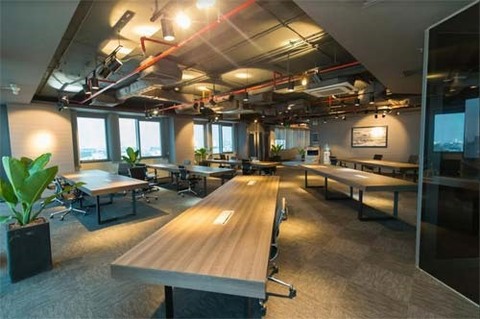
Viet Nam has seen strong development in co-working spaces in recent years, and the growth will be higher in future. – Photo daubao.com
Viet Nam has seen strong development in co-working spaces in recent years, and the growth will be higher in future, according to CBRE Viet Nam, a foreign property consulting company.
According to CBRE Viet Nam’s press release on May 28, as of April 2018, there are 19 co-working spaces (CWSs) in Ha Noi and 15 CWSs in HCM City, with more than 23 co-working operators, inclusive of two international CWS operators.
The number of co-working spaces has grown by 62 per cent from 2017 and has recorded a 55 per cent growth rate per annum over the past five years.
By the end of this year, the number of co-working spaces is expected to increase to 45, with Ha Noi and HCM City accounting for 56 per cent and 44 per cent of the market share, respectively.
Major local operators, including Toong, UP, Circo and Dreamplex, are all expanding quickly, with each accounting for a smaller share of the market compared to 2017. However, as the market is expanding in terms of venues and operators, smaller operators with only one venue are also opening CWSs rapidly, growing from 30 per cent last year and expecting 42 per cent of the market share by the end of 2018.
Meanwhile, major local operators still own, on an average, 12 per cent of the market share each, according to CBRE Viet Nam.
Foreign entrants such as NakedHub from China and Hive from Hong Kong have started to make their mark on the market, with Hive planning to open another venue in the centre of HCM City by the end of this year and NakedHub launching two venues, one each in HCM City and Ha Noi, in the second quarter of 2018. Other international CWS operators are also looking forward to entering Viet Nam in the next two years.
The CWS movement in Viet Nam will continue to expand in future in terms of supply and niche offerings to their targeted tenants. Foreign CWS operators are aggressively trying to find space, especially in Grade A office buildings as well as upscale Grade B buildings in prime central business district (CBD) areas to establish both brands and market share within Viet Nam.
Both HCM City and Ha Noi are neck to neck in terms of demand because operators reported a general 75-80 per cent average occupancy rate in both the markets as of April.
High demand and the fact that the market is still relatively new compared to Asia Pacific countries will create opportunities for upcoming M&A (merger and acquisition) activities among local and foreign co-working spaces, CBRE Viet Nam said.
Previously, CWSs in Viet Nam were generally not located in prime buildings or areas as operators needed to keep rental costs at a manageable level. They were usually found in underutilised buildings in decentralised locations, especially the CBD-fringe. Both Toong and UP, major CWS operators in Viet Nam, operate their centres from Grade B or lower-grade buildings.
In Ha Noi, a few CWSs are located in Cau Giay district, an emerging office cluster, while CWSs in HCM City tend to be more spread out among CBD-fringe districts such as District 1, 2, 3, 4, Binh Thanh and Phu Nhuan.
The cost of renting a co-working space varies across cities. Co-working spaces in Ha Noi and HCM City are currently priced lower than most other cities in the Asia Pacific, which reflects the general advantage of renting office spaces in Viet Nam.
In HCM City, as some co-working space operators had expanded in the CBD area in the beginning of 2018, pricing for private offices reportedly increased from 30-50 per cent in venues in central districts.
According to a study by CBRE Research Viet Nam in 2017, 91 per cent of people using a co-working space are millennials, i.e. under the age of 35. This proportion is a lot higher than the global average of 67 per cent and reflects Viet Nam’s young demography, which offers a good source of demand for CWSs.
In 2017, CBRE Research Viet Nam estimated that 54 per cent of users in Ha Noi and HCM City were either the founders or employees of start-ups, while approximately 14 per cent were freelancers and self-employed. These start-ups included both local and overseas firms.
The study also found that more than 55 per cent of CWS users worked in the IT industry, with the remaining spread across various sectors, including tourism, finance-banking, education, marketing and real estate. - VNS